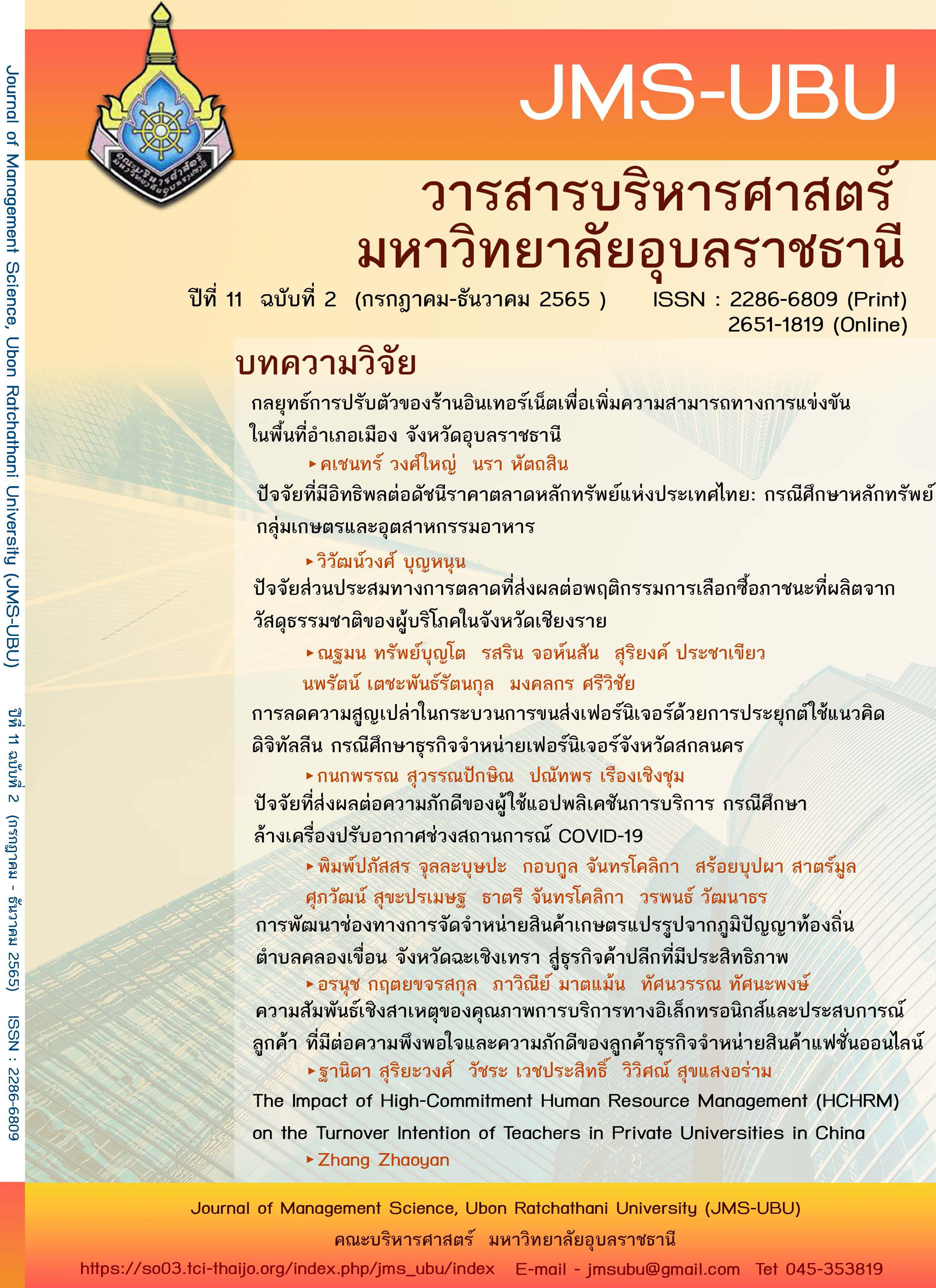ปัจจัยที่ส่งผลต่อความภักดีของผู้ใช้แอปพลิเคชันการบริการ กรณีศึกษา ล้างเครื่องปรับอากาศช่วงสถานการณ์ COVID-19
Main Article Content
บทคัดย่อ
การวิจัยนี้มีวัตถุประสงค์เพื่อระบุปัจจัยที่ส่งผลต่อความภักดีของผู้ใช้แอปพลิเคชันการบริการ กรณีศึกษา ล้างเครื่องปรับอากาศ ช่วงสถานการณ์ COVID-19 และเพื่อเปรียบเทียบความแตกต่างด้านปัจจัยที่ส่งผลต่อความภักดีของผู้ใช้แอปพลิเคชันล้างเครื่องปรับอากาศของภาครัฐวิสาหกิจ (กฟภ.) และภาคเอกชน โดยมีกรอบแนวคิดของงานวิจัยประยุกต์จาก แบบจำลองการยอมรับเทคโนโลยี แบบจำลองรูปแบบการรับรู้-ผลกระทบ-พฤติกรรม และทฤษฎีแรงจูงใจเพื่อป้องกัน
การวิจัยนี้เป็นการวิจัยเชิงปริมาณเก็บข้อมูลโดยใช้แบบสอบถาม โดยสุ่มตัวอย่างแบบชั้นภูมิ (Stratified Random Sampling) จากผู้ใช้แอปพลิเคชันล้างเครื่องปรับอากาศบนสมาร์ทโฟนจำนวน 420 คน ในประเทศไทย ในช่วงเดือน พฤศจิกายน 2563 - กรกฎาคม 2564 และวิเคราะห์ข้อมูลด้วยแบบจำลองสมการโครงสร้าง
ผลการวิจัยพบว่า 1. ปัจจัยที่ส่งผลต่อความภักดีของผู้ใช้แอปพลิเคชันล้างเครื่องปรับอากาศอย่างมีนัยสำคัญทางสถิติ ประกอบด้วย คุณภาพของเมนูการใช้งาน การรับรู้การใช้งานง่าย ความพึงพอใจ ทัศนคติในการใช้งาน การรับรู้ประโยชน์ ต้นทุนการเปลี่ยน การรับรู้การป้องกัน และการรับรู้ความปลอดภัย ตามลำดับ 2. ผู้ใช้งานแอปพลิเคชัน Pea Hero Care and Service ปัจจัยด้านต้นทุนการเปลี่ยนที่ส่งผลต่อความภักดีสูงกว่าผู้ใช้งานแอปพลิเคชันอื่น แต่ผู้ใช้งานแอปพลิเคชันอื่น ปัจจัยด้านความพึงพอใจที่ส่งผลต่อความภักดีที่สูงกว่าผู้ใช้งานแอปพลิเคชัน PEA Hero Care and Service
Downloads
Article Details

อนุญาตภายใต้เงื่อนไข Creative Commons Attribution-NonCommercial-NoDerivatives 4.0 International License.
บทความที่ตีพิมพ์ในวารสารบริหารศาสตร์ มหาวิทยาลัยอุบลราชธานี เป็นลิขสิทธิ์ของวารสาร โดยเนื้อหาและความคิดเห็นในบทความเป็นความรับผิดชอบของผู้เขียนแต่ละท่าน ไม่เกี่ยวข้องกับคณะบริหารศาสตร์ มหาวิทยาลัยอุบลราชธานีแต่อย่างใด และหากมีข้อผิดพลาดประการใด ผู้เขียนจะเป็นผู้รับผิดชอบต่อบทความของตนเองแต่เพียงผู้เดียว
เอกสารอ้างอิง
ฐะนุพงศ์ ศรีกาฬสินธุ์, อรรถศิษฐ์ พัฒนะศิริ และ อัญชนา กลิ่นเทียน (2563). Digital Disruption: เรากำลังถูกเทคโนโลยีทำลายล้างจริงหรือไม่? แล้วอะไรทำให้เกิด Digital Disruption?. สืบค้นเมื่อ 19 กันยายน 2564, จาก http://cosci.swu.ac.th/news-event/cas/2020/digital-disruption
ธนาคารไทยพาณิชย์. (2563). Future of Marketing: การตลาดดิจิทัล อาวุธโลกธุรกิจหลังโควิด-19. สืบค้นเมื่อ 20 กันยายน 2564, จาก https://www.scb.co.th/th/personal-banking/stories/business-maker/future-of-marketing.html
พัชราภรณ์ วรโชติกำจร และ สิทธิชัย วรโชติกำจร. (2563). การอยู่รอดจากการเปลี่ยนฉับพลันทางดิจิทัล. สืบค้นเมื่อ 19 กันยายน 2564, จาก http://cosci.swu.ac.th/news-event/cas/2020/digital-disruption
สำนักงานพัฒนาธุรกรรมทางอิเล็กทรอนิกส์. (2564). แผนยุทธศาสตร์เกี่ยวกับธุรกรรมทางอิเล็กทรอนิกส์ พ.ศ. 2564 - 2565. สืบค้นเมื่อ 5 พฤศจิกายน 2564, จาก https://www.etda.or.th/th/Useful-Resource/ET-Strategic-Plan-64-65.aspx
Ajzen, I., & Fishbein, M. (1975). A bayesian analysis of attribution processes. Psychological Bulletin, 82(2), 261-277.
Burnham, T. A., Frels, J. K., & Mahajan, V. (2003). Consumer switching costs: A typology, antecedents, and consequences. Journal of the Academy of Marketing Science, 31(2), 109-126.
Chang, H. H., & Chen, S. W. (2009). Consumer perception of interface quality, security, and loyalty in electronic commerce. Information & Management, 46(7), 411-417.
Chuang, J. H., Wang, J. H., & Liang, C. (2020). Implementation of internet of things depends on intention: Young farmers’ willingness to accept innovative technology. International Food and Agribusiness Management Review, 23(2), 253-265.
Davis, F. D. (1989). Perceived usefulness, perceived ease of use, and user acceptance of information technology. MIS Quarterly, 13(3), 319-340.
Dunn, S. P., & Rogers, R. W. (1986). Protection motivation theory and preventive health: Beyond the health belief model. Health Education Research, 1(3), 153-161.
Koufaris, M., & Hampton-Sosa, W. (2004). The development of initial trust in an online company by new customers. Information & Management, 41(3), 377-397.
Mitchev, T., & Chompu Nuangjamnong. (2021). The impact of e-commerce on customer satisfaction and customer loyalty during the COVID-19 pandemic: A quantitative analysis in Thailand. AU-GSB E-Journal, 14(2), 59-70.
Mulyana, A., Disman, D., Wibowo, L., & Hurriyati, R. (2020). Application of customer behavior in using fintech as business media based on the unified theory of acceptance and use of technology model. In The 3rd Global Conference on Business, Management, and Entrepreneurship (GCBME 2018) (pp. 69-75). Bandung: Atlantis Press.
Pourabedin, Z., Foon, Y. S., Chatterjee, R. S., & Ho, J. S. Y. (2016). Customers' online channel switching behavior: The moderating role of switching cost. Information, 19(7B), 2961-2970.
Prentice, C., Lopes, S. D, & Wang, X. (2020). The impact of artificial intelligence and employee service quality on customer satisfaction and loyalty. Journal of Hospitality Marketing & Management, 29(7), 739-756.
Rogers, R. W. (1975). A protection motivation theory of fear appeals and attitude change1. The Journal of Psychology, 91(1), 93-114.
Samudro, A., Sumarwan, U., Yusuf, E. Z., & Simanjuntak, M. (2018). Perceived value, social bond, and switching cost as antecedents and predictors of customer loyalty in the B2B chemical industry context: A literature review. International Journal of Marketing Studies, 10(4), 124-138.
Venkatesh, V., & Davis, F. D. (2000). A theoretical extension of the technology acceptance model: Four longitudinal field studies. Management Science, 46(2), 186-204.
Wang, J., Liu-Lastres, B., Ritchie, B. W., & Mills, D. J. (2019). Travelers’ self-protection against health risks: An application of the full Protection Motivation Theory. Annals of Tourism Research, 78. DOI: 10.1016/j.annals.2019.102743

